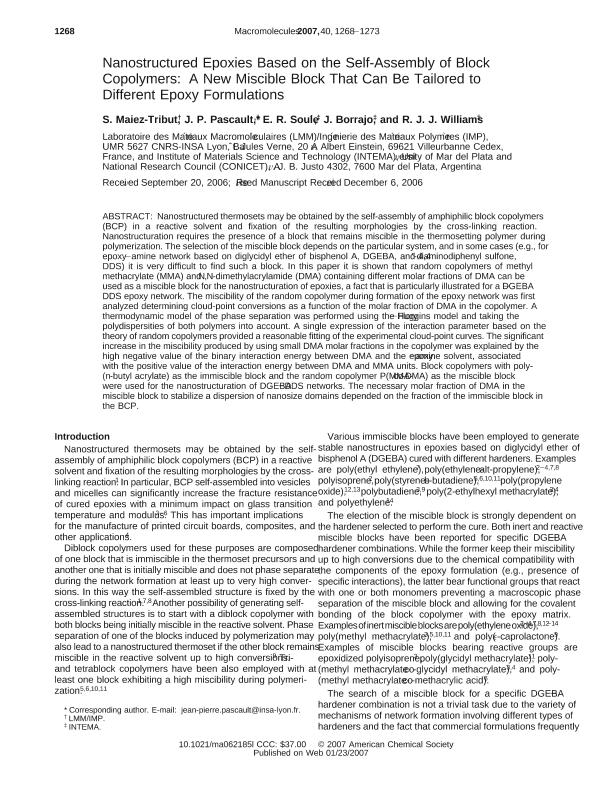Artículo
Nanostructured epoxies based on the self-assembly of block copolymers: A new miscible block that can be tailored to different epoxy formulations
Maiez Tribut, S.; Pascault, J. P.; Soulé, Ezequiel Rodolfo ; Borrajo Fernandez, Julio
; Borrajo Fernandez, Julio ; Williams, Roberto Juan Jose
; Williams, Roberto Juan Jose
 ; Borrajo Fernandez, Julio
; Borrajo Fernandez, Julio ; Williams, Roberto Juan Jose
; Williams, Roberto Juan Jose
Fecha de publicación:
02/2007
Editorial:
American Chemical Society
Revista:
Macromolecules
ISSN:
0024-9297
Idioma:
Inglés
Tipo de recurso:
Artículo publicado
Clasificación temática:
Resumen
Nanostructured thermosets may be obtained by the self-assembly of amphiphilic block copolymers (BCP) in a reactive solvent and fixation of the resulting morphologies by the cross-linking reaction. Nanostructuration requires the presence of a block that remains miscible in the thermosetting polymer during polymerization. The selection of the miscible block depends on the particular system, and in some cases (e.g., for epoxy-amine network based on diglycidyl ether of bisphenol A, DGEBA, and 4,4′-diaminodiphenyl sulfone, DDS) it is very difficult to find such a block. In this paper it is shown that random copolymers of methyl methacrylate (MMA) and N,N-dimethylacrylamide (DMA) containing different molar fractions of DMA can be used as a miscible block for the nanostructuration of epoxies, a fact that is particularly illustrated for a DGEBA-DDS epoxy network. The miscibility of the random copolymer during formation of the epoxy network was first analyzed determining cloud-point conversions as a function of the molar fraction of DMA in the copolymer. A thermodynamic model of the phase separation was performed using the Flory-Huggins model and taking the polydispersities of both polymers into account. A single expression of the interaction parameter based on the theory of random copolymers provided a reasonable fitting of the experimental cloud-point curves. The significant increase in the miscibility produced by using small DMA molar fractions in the copolymer was explained by the high negative value of the binary interaction energy between DMA and the epoxy-amine solvent, associated with the positive value of the interaction energy between DMA and MMA units. Block copolymers with poly-(n-butyl acrylate) as the immiscible block and the random copolymer P(MMA-co-DMA) as the miscible block were used for the nanostructuration of DGEBA-DDS networks. The necessary molar fraction of DMA in the miscible block to stabilize a dispersion of nanosize domains depended on the fraction of the immiscible block in the BCP.
Archivos asociados
Licencia
Identificadores
Colecciones
Articulos(INTEMA)
Articulos de INST.DE INV.EN CIENCIA Y TECNOL.MATERIALES (I)
Articulos de INST.DE INV.EN CIENCIA Y TECNOL.MATERIALES (I)
Citación
Maiez Tribut, S.; Pascault, J. P.; Soulé, Ezequiel Rodolfo; Borrajo Fernandez, Julio; Williams, Roberto Juan Jose; Nanostructured epoxies based on the self-assembly of block copolymers: A new miscible block that can be tailored to different epoxy formulations; American Chemical Society; Macromolecules; 40; 4; 2-2007; 1268-1273
Compartir
Altmétricas



